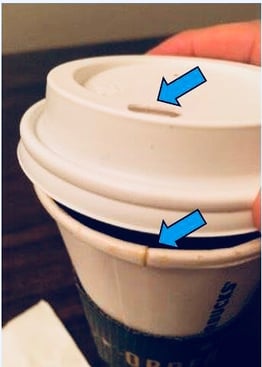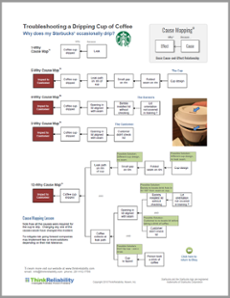The simple logic of troubleshooting
If you’re a coffee drinker, you may have experienced a dripping cup. Most disposable coffee cups, like the ones at Starbucks, have a seam down the side. These cups sometimes drip. As far as problems go, it’s minor, but the process for troubleshooting a leaking cup is the same for all problems - from minor annoyances to the most complex incidents.
Problem solving, troubleshooting and root cause analysis are not three different approaches. All three are based on the simple concept of evidence-based cause-and-effect that applies consistently to all problems.

A systematic approach
Someone troubleshooting the dripping cup may start by testing something obvious. Is the lid on all the way? It’s a simple way to rule out one possibility. But in this case the lid is tight.
The troubleshooter now needs to get additional information by looking at the system. The cup is examined by holding it up to see under the edge of the lid. One observation is that the cup is smooth, except for the area at the seam. To get a better look, the troubleshooter might now remove the lid, which will reveal a tiny gap on the rim of the cup at the seam.

Test the hypothesis
Is the drip occurring because that tiny gap lines up with the hole in the lid? It’s possible, but the troubleshooter doesn’t know for sure. A potential explanation without sufficient evidence is called a hypothesis.
To test this idea, the troubleshooter rotates the lid to locate the hole in the lid opposite the seam on the cup. This is a simple experiment to help determine if the gap and lid are related to the leak. Troubleshooting is an iterative process of collecting information and supporting evidence to understand the cause-and-effect relationships within an issue.
Conventional mistake – too much speculation
Contrast the troubleshooter’s systematic approach with what some organizations do. Companies may teach a variety of different problem-solving techniques, each with its own terminology and categorization scheme. Employees have learned that identifying possible causes is important, so they make a list.
However, a problem happened because of causes that actually occurred, not possible causes that could have. But, if you encourage people to speculate, they will. Listing all the possible causes is a great way to build a troubleshooting guide or to start an FMEA (failure modes effects analysis), but for a specific problem it detracts from what did happen. The only reason a troubleshooter identifies possible causes is because they’re stumped. Specific details need to be collected to keep moving forward. Remember root cause analysis is an iterative process
Scientific approach
Troubleshooting and root cause analysis merely uncover the structure contained within the problem. Many people believe the technique is what provides the structure. That’s what the technique taught them. But a scientific approach recognizes that the order is already in the problem. The troubleshooter simply needs to reveal what it is.
To do this the troubleshooter needs to know the system well. They’ll need to understand the relevant pieces to the coffee cup and lid and how they interact. It’s obvious that the cup drips. We need to identify exactly what’s causing it. Asking people to begin by speculating distracts from a focused, evidence-based approach.
How to prevent it – check that the lid is 180°
Now that the hole on the lid is not lined up with the seam on the cup, the troubleshooter has discovered that the cup no-longer drips.
The next time you get a cup of coffee note how the lid is positioned on the cup. Did the barista turn the hole opposite the seam? Some do, but some don't. Is it part of barista training? Is it something they do on their own? Do they even know about the drip issue? The training program at the coffee house should include “Proper Lid Orientation.” Does it?
And, even if the lid is not on properly, you can re-position the lid yourself to prevent a leak. No matter who positions the lid properly, either solution prevents this problem. This may seem like a minor step, but it’s just a question of how specific your company’s work processes and training programs need to be.
The answer is, specific enough to prevent the problems. Notice how the cause-and-effect analysis pinpoints the specific changes in work processes. It’s an important part of the problem-solving mindset we teach.
Cause Map for the dripping coffee cup
Click the image below to see the Cause Map for this dripping coffee cup. 
Notice how basic the analysis begins. As the causes are exposed, different solution options are revealed. Identifying all the different ways a cup can drip is different than troubleshooting one specific dripping coffee cup (causes versus all the possible causes).
The Cumulative Cause Map shows how all the possible causes can be captured, and is also shown in the Cause Map example above. The possible causes of a leaking coffee cup should be captured in a troubleshooting guide if the organization wants to learn how to prevent all of them.
Experiment with one of your problems
Don’t let problem solving be complicated in your organization. Focus on the basics to develop a systematic approach for dissecting all problems. This works the same for your frontline people, your technical leads as well as your leadership team.
Test our Cause Mapping method on one of your problems to get your own evidence. Find out if a Cause Map is easier to understand, more thorough, and provides better solutions than what you’re doing now.
Get started
Download our free 5-Why Cause Map Template and watch our Getting Started video. Becoming a better problem solver is good for your company and it’s good for your career.
Keep building your skills. If you’d like us to build a Cause Map for one of your incidents contact our root cause analysis help desk. One of our certified facilitators will lead you through the process.
Additional root cause analysis resources:
*Banner Image credit attribution: Boyloso / shutterstock.com













